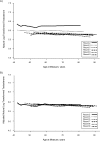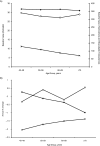Associations between longitudinal changes in serum estrogen, testosterone, and bioavailable testosterone and changes in benign urologic outcomes
- PMID: 21367876
- PMCID: PMC3070494
- DOI: 10.1093/aje/kwq438
Associations between longitudinal changes in serum estrogen, testosterone, and bioavailable testosterone and changes in benign urologic outcomes
Abstract
Some men have rapid increases in benign prostatic enlargement and lower urinary tract symptoms (LUTS), and it is not clear how sex steroid hormones contribute to the rates of change in these urologic outcomes. Therefore, the authors conducted a population-based cohort study of 648 men residing in Olmsted County, Minnesota, from 1990 to 2007, to examine associations between baseline sex steroid hormones, the rate of change in these hormones, and the rates of change in LUTS, maximum urinary flow rate, and prostate volume. Annual changes in hormone levels and urologic outcomes were calculated using mixed-effects regression models. Associations between hormone variables and rates of change in urologic outcomes were assessed with linear regression models. Higher baseline estradiol levels and rapid declines in estradiol over time were associated with rapid increases in LUTS and rapid decreases in maximum flow rate. Lower baseline bioavailable testosterone levels and more rapid declines in bioavailable testosterone were associated with more rapid increases in prostate volume. These results suggest that both absolute sex steroid hormone levels and the rates at which the levels change may be important in the development of urologic conditions in aging men.
Figures



References
-
- Griffiths K. Molecular control of prostate growth. In: Kirby R, McConnell JD, Fitzpatrick J, et al., editors. Textbook of Benign Prostatic Hyperplasia. Oxford, United Kingdom: Isis Medical Media Ltd; 1996. pp. 23–56.
-
- Guess HA. Benign prostatic hyperplasia: antecedents and natural history. Epidemiol Rev. 1992;14(1):131–153. - PubMed
-
- McConnell JD, Roehrborn CG, Bautista OM, et al. The long-term effect of doxazosin, finasteride, and combination therapy on the clinical progression of benign prostatic hyperplasia. N Engl J Med. 2003;349(25):2387–2398. - PubMed
-
- Kaplan SA, Roehrborn CG, McConnell JD, et al. Long-term treatment with finasteride results in a clinically significant reduction in total prostate volume compared to placebo over the full range of baseline prostate sizes in men enrolled in the MTOPS trial. J Urol. 2008;180(3):1030–1032. - PubMed
Publication types
MeSH terms
Substances
Grants and funding
LinkOut - more resources
Full Text Sources
Medical

